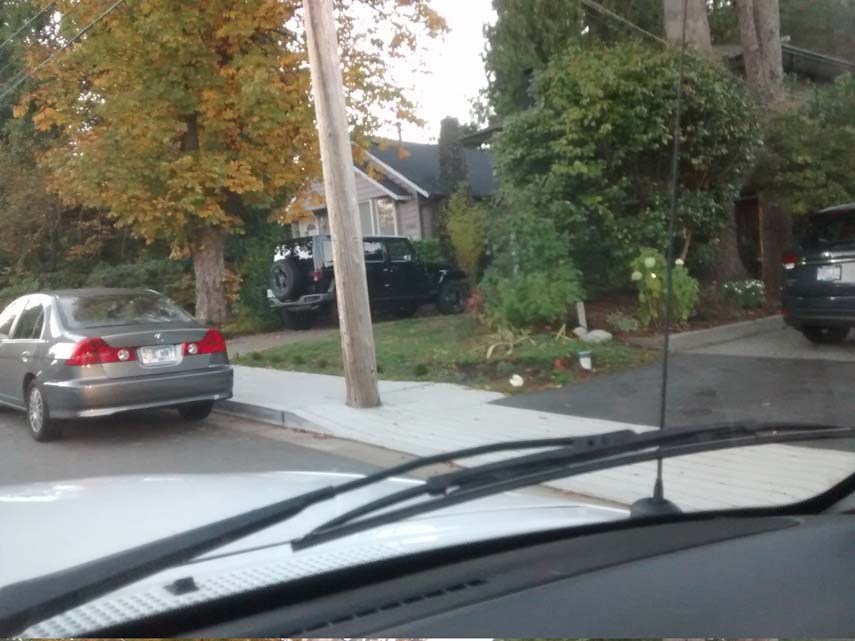Late last month, in a meeting at the District of North Vancouver, a cyclist, a pedestrian and a disabled person found common ground.
Instead of discussing the broad visions of the district’s official community plan, or initiatives like Vision Zero or Barrier Free BC, talk turned to one of those mundane problems faced by anyone travelling without a car: telephone poles in the middle of sidewalks.
It sounds like a small thing to complain about if you compare it to the daily jams on the Upper Levels highway, but for anyone trying to travel the district on foot, by bike, or in a wheelchair, these poles can be as big a barrier as a stalled semi on the Ironworkers Memorial Second Narrows Crossing.
The reasons why we wind up with poles in the middle of sidewalks are complicated.
Sometimes it’s budgetary.Cash-strapped governments – because we all want to pay less tax – may decide that a less-than-perfect sidewalk is better than no sidewalk at all. Leaving a pole in the middle of the path means avoiding spending large amounts of money to move utilities, or to re-engineer larger projects to move the sidewalk.
And there are jurisdictional issues – utility poles are often the domain of the utility companies, not the district. Moving a pole requires negotiating with BC Hydro, or Telus or whoever has wires on it.
Even so, people who rely on sidewalks – or shared paths used by both cyclists and walkers – often find themselves asking, “Who, exactly, thought that leaving a pole in the middle of the sidewalk was a good idea?”
Or, less charitably, “And can they show me a road for cars with a pole in the middle of the lane?”
The district’s own Pedestrian Master Plan (dnv.org/property-and-development/pedestrian-master-plan) makes some pretty specific recommendations.
It recommends explicitly that the district “adopt a policy to prioritize pedestrians over all other modes of travel or to consider pedestrian needs in decision-making.”
The master plan also makes some specific recommendations about how sidewalks should be built, suggesting that “A complete sidewalk network also includes a continuous ‘clear zone’ (path free of any obstacles) of at least 1.5 metres width ...”
Despite this, it still appears that plans are made first and foremost to keep cars moving easily, with pedestrians, cyclists and disabled residents expected to settle for whatever scraps of attention or budget remain after the “important” decisions are made.
This month the district has been looking for public feedback from users of East 29th Street, between Lonsdale and Lynn Valley.
Drivers of that route will immediately point to the intersection of William and 29th for attention, but this is also a good time to look at the lack of crosswalks at any other place on 29th, and to eliminate the poles, sign posts and benches that make the district sidewalks an obstacle course.
Or even, just for a change, to plan first to fix the sidewalks and crosswalks, then use the left over budget to make improvements for cars.
Further afield at the Seylynn development, cyclists who need to travel between Keith Road to Lower Lynn or Deep Cove are faced with brand new poles, bollards and other obstacles that look wonderful if you’re planning for cars, but put both pedestrians and walkers at risk.
Surely brand new developments should try to make sure that everyone using our roadways is treated as equally important?
These are the kinds of obstacles that could have been easy to avoid at the time of construction. Instead someone – the developer? The district? – is faced with an expensive upgrade.
The district’s Pedestrian Master Plan sets a specific goal: to have district residents make 10 per cent of all trips on foot by the year 2031.
That’s pretty far off, so let’s bring the discussion closer to home.
A lot of people talk about maintaining a “village” atmosphere in Lynn Valley.
To me that means getting people out of their cars to walk, bike or roll so that they meet face to face, talk and make connections with their neighbours.
Dog owners know this already. You can’t take Rover for a walk without stopping to talk to the people you meet.
Every day we leave home to do shopping, visit the library or have a beer with friends. If you can leave your car at home and travel on foot, or with a stroller or wheelchair, you’ll actually find yourself getting to know the people around you, and will see your community in much different ways.
Ultimately you’ll make friendships and alliances that will enrich your day-to-day life, and make the district the best possible place to live, work and even retire.
If that’s our priority, and I think that it is, then our sidewalks and shared trails should be treated as equally important as the roads we drive on.
Barry Rueger is a Lynn Valley writer, dog walker, non-profit board member, and for several years has been part of the district’s transportation consultation committee.
What are your thoughts? Send us a letter via email by clicking here or post a comment below.



